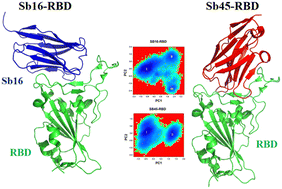Binding of synthetic nanobodies to the SARS-CoV-2 receptor-binding domain: the importance of salt bridges†
Abstract
In this study, five different SARS-CoV-2 receptor-binding domain (RBD) models were created based on the crystal structures of RBD complexes with two synthetic nanobodies (Sb16 and Sb45). Microsecond all-atom MD simulations revealed that Sb16 and Sb45 substantially stabilized the flexible RBD loop (residues GLU471–SER494) due to the salt bridges and hydrogen bonding interactions between RBD and the synthetic nanobodies. However, the calculation of binding free energy displayed that Sb45 had a higher binding affinity to RBD than Sb16, in agreement with the experimental result. This is because Sb45 has stronger electrostatic attraction to RBD as compared to Sb16. In particular, the salt bridge GLU484–ARG33 in Sb45-RBD is stronger than the GLU484–LYS32 in Sb16-RBD. Furthermore, by comparing the binding affinity of Sb16 for two RBD mutants (E484K and K417N), we found that E484K mutation substantially reduced the binding affinity to Sb16, and K417N mutation had no significant effect, qualitatively in agreement with experimental studies. According to the binding free energy calculation, the strong electrostatic repulsion between LYS32 and LYS484 caused by E484K mutation destroys the salt bridge between LYS32 and GLU484 in the RBD wild type (WT). In contrast, the binding of the K417N mutant to Sb16 effectively maintains the salt bridge between LYS32 and GLU484. Therefore, our research suggests that the salt bridges between RBD and synthetic nanobodies are crucial for binding synthetic nanobodies to RBD, and a SARS-CoV-2 variant can escape neutralization from nanobodies by creating electrostatic repulsion between them.



 Please wait while we load your content...
Please wait while we load your content...